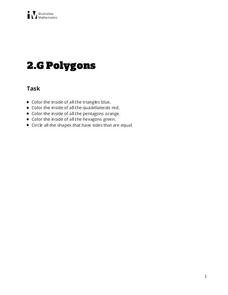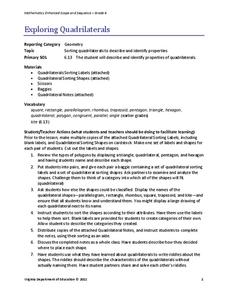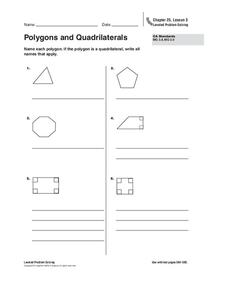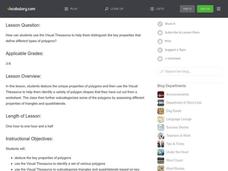Curated OER
Exploring Polygons and The Greedy Triangle
Excellent lesson! Anne Linehane's geometry story, The Greedy Triangle, offers an opportunity to practice forming various types of polygons with your learners. Using elastic bands (or Chinese jump ropes),...
Illustrative Mathematics
Polygons
Identify shapes based on their attributes. Second graders are tasked to color triangles, quadrilaterals, pentagons, and hexagons specific colors. The one thing these shapes have in common? They are all polygons.
Willow Tree
Interior Angles, Exterior Angles, and Diagonals of Polygons
How does the number of sides of a polygon affect the angle measures? Learners recognize a pattern in finding the total measure of interior and exterior angles and the number of diagonals. They use the patterns to calculate...
Curated OER
Naming Polygons
What polygon is this? Young geometers categorize shapes by circling all the quadrilaterals in a set of figures. Next, they write the names of 10 polygons using a visual guide as reference. Review the guide together before they start if...
Utah Education Network (UEN)
Create, Classify, and Sort Quadrilaterals
Quadrilaterals can be quirky! Fourth graders use geoboards and bands to create four-sided figures. They analyze the attributes such as angle size and presence of parallel sides. As a result they learn to differentiate among...
Alabama Learning Exchange
Polygons-Changing Area Versus Changing Perimeter
Investigate the area and perimeter of polygons in this geometry lesson. Young geometers use grid paper to draw a quadrilateral and calculate its area and perimeter. They also read The Greedy Triangle to identify the changing shape of...
Curated OER
Polygons
This resource provides 5 different worksheets on the topic of polygons and symmetry. These worksheets cover rotational symmetry, lines of symmetry, symmetry of regular polygons, special quadiralaterals, and polygon transformation. The...
Kuta Software
Polygons and Angles
Get out those protractors! Geometers measure interior and exterior angles of 10 polygons, including a 24-gon. They also calculate the interior angle sum of the polygons.
Curated OER
Naming Quadrilaterals
Scholars examine six common quadrilaterals and identify each by writing its name beneath the shape. Next, they sketch four shapes: parallelogram, rectangle, rhombus, and trapezoid. Once finished, review which features helped...
Virginia Department of Education
Exploring Quadrilaterals
Sort this resource into the Use pile. Scholars investigate attributes of quadrilaterals and then use the results to sort and classify the shapes labeling each figure with their properties to justify the classifications.
EngageNY
Perimeter and Area of Polygonal Regions in the Cartesian Plane
How many sides does that polygon have? Building directly from activity number eight in this series, learners now find the area and perimeter of any polygon on the coordinate plane. They decompose the polygons into triangles and use...
Virginia Department of Education
Properties of Quadrilaterals
What type of quadrilateral is that? Discover the difference between the types of quadrilaterals. Small groups investigate types of quadrilaterals using geometry software to find their properties. To keep track of the different...
Mathed Up!
Angles in Polygons
Show your class that finding angle measures is a regular calculation with a resource that provides 12 problems dealing with the measures of angles in regular polygons. Pupils use formulas for the sum of measures of angles in a polygon to...
Curated OER
Polygons and Quadrilaterals
In this polygons and quadrilaterals practice worksheet, learners sharpen their problem solving skills as they solve 6 story problems.
Curated OER
Know Your Polygons!
Young scholars identify and categorize different polygons. In this polygons lesson plan, students research and identify properties of polygons, identify different polygon shapes, and categorize different triangles and quadrilaterals.
Curated OER
Symmetry Using Polygons
Working on symmetry in your class? If so, this worksheet might be for you. Learners observe different triangles and quadrilaterals, determine which are symmetrical, draw in the lines of symmetry, and color the symmetrical shapes. In...
Curated OER
Countdown Challenge: Live Symmetry in Regular & Irregular Polygons
In this symmetry worksheet, students identify lines of symmetry in given polygons. They discover the correlation between the number of sides and the number of lines of symmetry. Students determine the lines of symmetry in irregular...
Curated OER
Finding the Area and Perimeter of Polygons
Seventh graders practice finding the area and perimeter of polygons. In this polygon area lesson, 7th graders brainstorm shapes and take a walk to locate shapes. Students record properties of shapes and use various shapes to make a...
Curated OER
2-D polygons
A hands-on activity uses the Zome modeling system, and helps young geometers either learn or review their knowledge of polygons. Students build as many different 2-dimensional polygons as possible: triangle, square, rectangle, pentagon,...
Curated OER
Investigation-Looking at Polygons
Eighth graders plot points and investigate polygons. They locate a point, using ordered pairs of integers on the coordinate plane. Students compare geometric measurements and computations on coordinate axes as they are applied to...
Curated OER
Identify Polygons: Algebra/Geometry Institute
Eighth graders classify geometric figures. In this polygon lesson, 8th graders identify given geometric figures. They compare and contrast different polygons. Students name line segments, identify parallel lines, and...
Curated OER
Area of Polygons
In this area of polygons worksheet, 10th graders solve and complete 12 various types of problems. First, they find the area of a given square. Then, students find the length of an original square as illustrated. They also write an...
Curated OER
Regular & Irregular Polygons
For this polygons worksheet, 7th graders identify and complete 8 different problems that include determining the types of various polygons. First, they use the table to the left to color each of the polygons illustrated. Then, students...

























